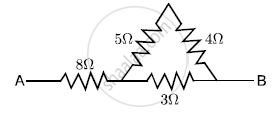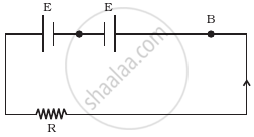Advertisements
Advertisements
Questions
Will current flow more easily through a thick wire or a thin wire of the same material, when connected to the same source? Why?
Will current flow more easily through a thick wire or a thin wire of the same material when connected to the same source? Give reason for your answer.
Solution 1
The current will flow more easily through thick wire. It is because the resistance of a
conductor is inversely proportional to its area of cross-section. If thicker the wire, less is resistance and hence more easily the current flows.
Solution 2
Resistance (R) is inversely proportional to the area of the cross-section (A) of the
wire. So, thicker the wire, lower is the resistance of the wire and vice-versa.
Therefore, current can flow more easily through a thick wire than a thin wire.
`R = rho xx l/A`
`R ∝ 1/A`
Solution 3
The resistance of a conductor is inversely proportional to its area of cross-section, i.e. `R ∝ 1/A`. So as the conductor is a thick wire, its resistance decreases and current will flow easily through it, in comparison with a thin wire.
APPEARS IN
RELATED QUESTIONS
Is Ohm’s law universally applicable for all conducting elements? If not, give examples of elements which do not obey Ohm’s law.
Name the unit of electrical resistance and give its symbol.
Name the law which is illustrated by the above V−I graph.
The graph between V and I for a conductor is a straight line passing through the origin.
What should remain constant in a statement of this law?
Four resistances of 16 ohms each are connected in parallel. Four such combinations are connected in series. What is the total resistance?
In a conductor 6.25 × `10^16` electrons flow from its end A to B in 2 s. Find the current flowing through the conductor (e = 1.6 × `10^-19` C)
A wire of resistance 9 ohm having length 30 cm is tripled on itself. What is its new resistance?
A wire has a length of 2.0 m and a resistance of 5.0 Ω. Find the electric field existing inside the wire if it carries a current of 10 A.
How does an increase in the temperature affect the specific resistance of a :
(i) Metal and
(ii) Semiconductor ?
Calculate the effective resistance across AB?

What are ohmic conductors? Give one exmaple. Draw a graph showing the current-voltage relationship for an ohmic conductor.
Ohm’s law states the relationship between power and voltage.
Write a short note on superconductors?
The resistance of a nichrome wire at 0°C is 10Ω. If its temperature coefficient of resistivity of nichrome is 0.004/ °C, find its resistance of the wire at boiling point of water. Comment on the result.
Which of the following I-V graph represents ohmic conductors?
Assertion: The statement of Ohm’s law is K = IR.
Reason: V = IR is the equation which defines resistance.
Ohm's law deals with the relationship between ______
Two cells of same emf E but internal resistance r1 and r2 are connected in series to an external resistor R (Figure). What should be the value of R so that the potential difference across the terminals of the first cell becomes zero.
Why should an ammeter have low resistance?
A current of 3.2 mA flows through a conductor. If charge on an electron is - 1.6 × 10-19 coulomb, find the number of electrons that will pass each second through the cross section of that conductor.
